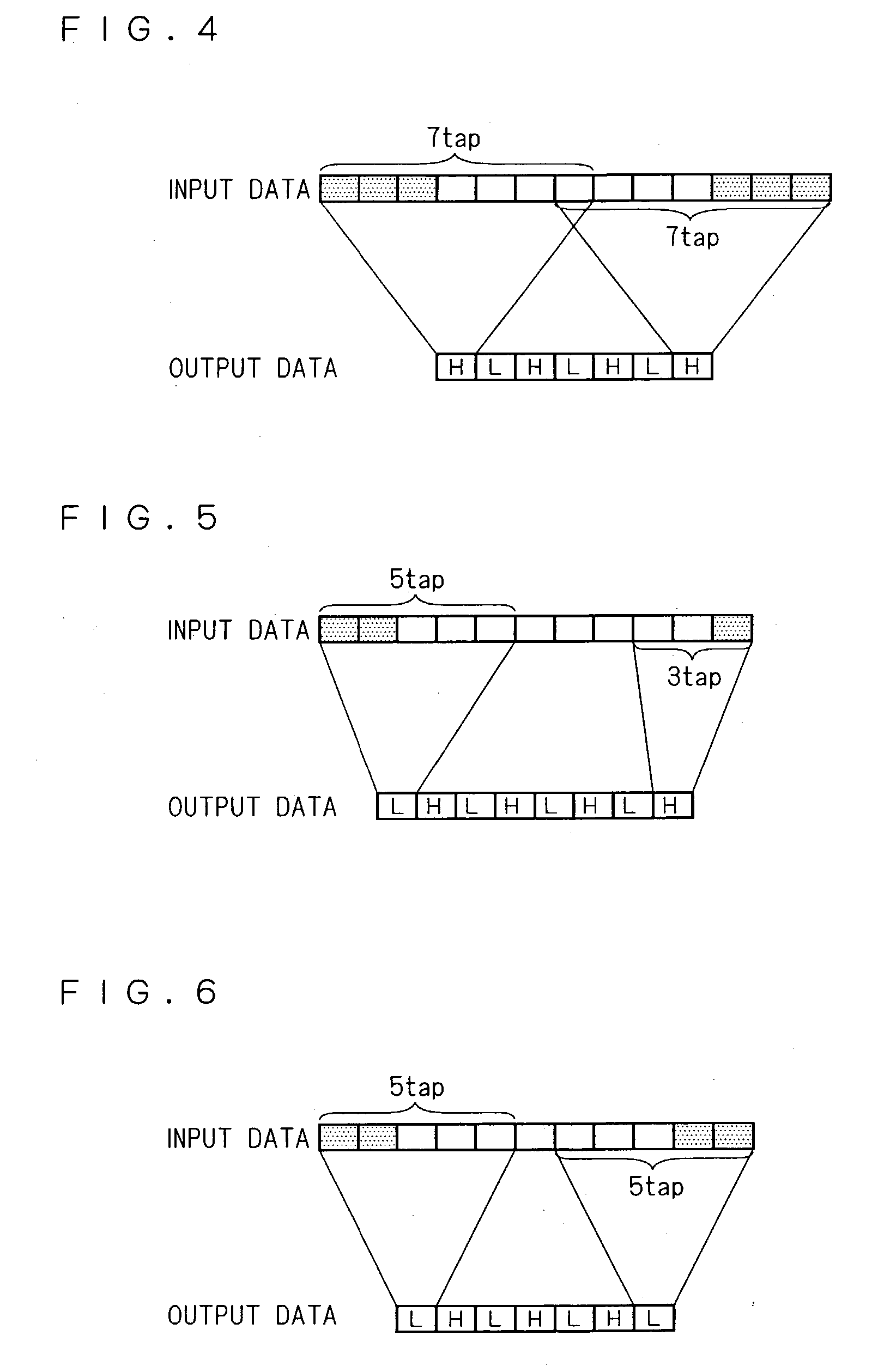Wavelet processing apparatus and wavelet processing method
a wavelet processing and wavelet processing technology, applied in the field of wavelet processing apparatus, can solve the problems of rectangular distortion becoming conspicuous, distortion occurring at the boundary of each tile, etc., and achieve the effect of reducing the memory capacity of the line memory and preventing image distortion
- Summary
- Abstract
- Description
- Claims
- Application Information
AI Technical Summary
Benefits of technology
Problems solved by technology
Method used
Image
Examples
first embodiment
[0138]In a first embodiment of the present invention, a wavelet processing apparatus shown in FIG. 16 is used. This wavelet processing apparatus includes: a block (readout block) 101 for reading out data in strip manner from an input image; a block (line-based wavelet transform block) 102 for performing a line-based wavelet transform on the data read out at the readout block 101; a block (data extraction block) 103 for extracting necessary data from the line-based wavelet transform block 102; a first memory device 104 for temporarily storing data when the wavelet transform is performed in the line-based wavelet transform block 102; and a second memory device 105 (large capacity memory device) 105 corresponding to a main memory which stores data for repeatedly and recursively performing wavelet transform on the output result from the data extraction block 103 as will be described later.
[0139]Then, in the present embodiment, as shown in FIG. 10 described above, the readout block 101 i...
second embodiment
[0148]In the first embodiment, by repeatedly performing the band decomposition using a line memory in which the number of decomposition levels is limited to three when performing the wavelet transform at each strip region 12, band decomposition of more than four-decomposition levels is enabled. In contrast to this, according to the present embodiment, an apparatus for executing a wavelet transform of three-levels as shown in FIG. 19 and an apparatus for executing a wavelet transform of two-levels as shown in FIG. 20 are used together for the purpose of reducing the number of entire memory accesses since an extra storage area required for processing one line is merely the area corresponding to 3+9+21=33 sets (11 for the 5×3 filter) from Table 1 the decomposition number of wavelet transform is three, and the area corresponding to 3+9=12 sets (four for the 5×3 filter) when the decomposition number of wavelet transform is two.
[0149]In this case, if it is so arranged that the data from t...
third embodiment
[0151]In the first embodiment and the second embodiment as described above, for the purpose of eliminating the necessity of handling the excess data in the vertical direction (see reference numeral 15 in FIG. 9), the wavelet transform is executed at a stroke on the strip regions 12 (12a,12b) in an image of one frame along the vertical direction. However, assuming that a predetermined block region 39 which is called “Precinct” shown in FIG. 21 is encoded in a predetermined raster scanning order, when each of strip regions 12 having decomposed into strips is subjected to wavelet transform as is in the above-described first and second embodiments, it is impossible to start the EBCOT encoding unless the entire one screen has been subjected to wavelet transform. To the contrary, when the image is decomposed in blocks as shown in FIG. 9, for example, in the vertical direction and the horizontal direction in a matrix to allow overhead of memory access in the vertical direction, it is possi...
PUM
 Login to View More
Login to View More Abstract
Description
Claims
Application Information
 Login to View More
Login to View More - R&D
- Intellectual Property
- Life Sciences
- Materials
- Tech Scout
- Unparalleled Data Quality
- Higher Quality Content
- 60% Fewer Hallucinations
Browse by: Latest US Patents, China's latest patents, Technical Efficacy Thesaurus, Application Domain, Technology Topic, Popular Technical Reports.
© 2025 PatSnap. All rights reserved.Legal|Privacy policy|Modern Slavery Act Transparency Statement|Sitemap|About US| Contact US: help@patsnap.com



